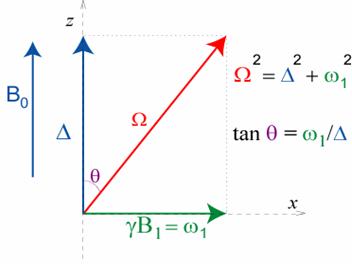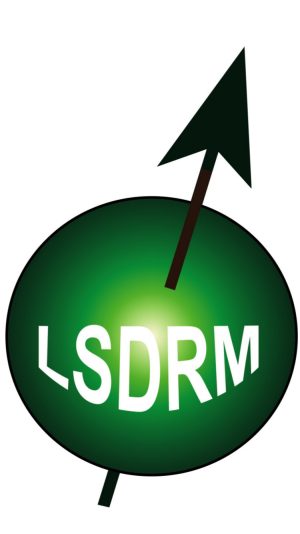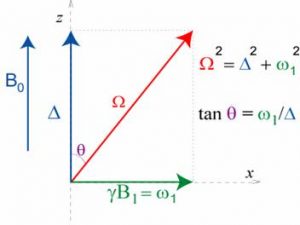Aim: The classical way to see relaxation in liquids is strongly associated to Bloch's equations, characterized by a longitudinal T1 and a transverse T2. This obviously needs to be extended in a first step to dipolar cross relaxation as explored by NOESY or ROESY experiments and in a further step to any mechanism involving cross-correlation induced relaxation. What we have studied for a while has led to the definition of a general unified view which links longitudinal relaxation along the static magnetic field direction and transverse one performed in the presence of rf irradiation.
Principle: The key point consists in applying the rf irradiation of amplitude ω1 not on-resonance as usual but off-resonance at a distance Δ in Hz from the spectrum centre. In the frame rotating at the rf field frequency this defines an effective field and we can study the relaxation along this field. This effective field makes an angle Θ=atan(ω1/Δ) with the static magnetic field direction and its amplitude Ω is defined by Ω2= ω12+Δ2.

Advantages:
- By varying the angle θ i.e. Δ and ω1, the direction of the effective field continuously varies from the longitudinal case to the transverse one. Obviously a large number of relaxation rates correlated by the θ and Δ values can be experimentally determined. Depending on the relaxation mechanisms considered two or more dynamic pieces of information can be obtained. Usually only two, the longitudinal and transverse relaxation rates, which correspond to θ=0 and θ = 90°. The precision on their determination is nevertheless increased since it benefits from the absolute relation between the measured rates and these two limit values which is dependent in a perfectible predictable way of the angle θ.
- By increasing the offset Δ it becomes possible to probe molecular dynamics at a scale on the order of 1/Ω which means about two orders of magnitude larger than what can be achieved by on-resonance rf irradiation. This allows the exploration of very slow overall dynamics or fast chemical exchange appearing in the micro to millisecond time scale, and in fact using this approach we had reported the fastest chemical exchange rate or the determination of the whole chemical exchange spectral density function.
- In term of implementation the two drawbacks of on-resonance rf irradiation studies disappear. Indeed a large offset D induces that chemical shift variation along the spectrum becomes negligible relative to this offset. However in term of in-phase coherence transfer due to scalar couplings J (Homonuclear Hartmann-Hahn transfer or TOCSY) the difference of chemical shifts between two protons remains non small relative to J, preventing this type of transfer. This remark has allowed us to propose the most reliable pulse sequence to study cross-relaxation between protons in small to medium size molecule, i.e. off-resonance ROESY or Tilted ROESY in the Bruker's nomenclature.

Steady-state or transient measurements:
- Variation of the signal intensities as a function of the mixing time is the straightforward protocol for exploring relaxation in the presence of off-resonance rf irradiation. We have used this principle for studying proton-proton dipolar cross-relaxation, proton-proton dipolar cross-correlation, nitrogen relaxation in proteins, proton or nitrogen chemical exchange, relaxation of paramagnetic proteins,…
- The measurement of the steady-state magnetization in the presence of off-resonance rf irradiation is an other protocol which directly gives access to dynamic parameters providing that a model of dynamics is chosen. This constraint is counterbalanced by the fact that thus each measurement provides dynamical information against which the model can be tested. This was a useful approach for fast determination of proton correlation times or of chemical exchange in proteins.
Reference :
H. Desvaux and P. Berthault, Progress in Nuclear Magnetic Resonance Spectroscopy, 35(4) (1999) 295.





